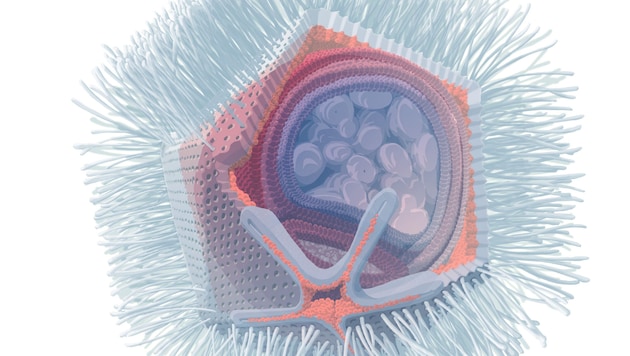Infects parasites
Fanged giant virus discovered in Klosterneuburg
Researchers have discovered a new type of giant virus at the wastewater treatment plant in Klosterneuburg near Vienna. However, they will not trigger a new pandemic - in fact, they are extremely useful. Using a sophisticated tactic, they attack brain-decomposing amoebae - one of the deadliest parasites for humans.
Specifically, we are talking about the protozoan Naegleria fowleri, which decomposes the brain of those affected after infection. Fortunately, the disease is rare and the protozoa are rarely found in our latitudes.
Unicellular organisms multiply in warm water
Naegleria are unicellular organisms that occur in bodies of water worldwide and feed on other microorganisms. The species Naegleria fowleri, the causative agent of a severe brain and meningitis called "primary amoebic meningoencephalitis" (PAM), mainly multiplies in warm waters above 30 degrees Celsius, according to the study published in the journal "Nature Communications". The disease - the protozoa are ingested via the nose when swimming, for example - is extremely rare, but is almost always fatal.
Counterparts from the group of "toilet neoviruses"
The team led by Patrick Arthofer and Matthias Horn from the Center for Microbiology and Environmental Systems Science at the University of Vienna has now been able to isolate giant viruses that infect various Naegleria species for the first time. They come from the group of "toilet neoviruses", whose name refers to a spectacular discovery in the Klosterneuburg sewage treatment plant a few years ago: Viennese microbiologists, with Horn's involvement, had come across various giant viruses during genome analyses at the time. The toilet neu viruses represent a group of viruses that were previously unknown to science.
Virus species possesses a particularly large number of genes
"They are particularly interesting among the giant viruses: they possess a particularly large number of genes that are otherwise only known from cellular organisms such as animals, plants, fungi or bacteria, and which would never have been associated with viruses before the discovery of toilet neoviruses," Horn told APA. It has also been shown "that toilet neoviruses are distributed worldwide and are very diverse".
In the current study, the researchers searched for viruses that infect amoebae of the genus Naegleria - and found what they were looking for in toilet neuviruses: The now discovered giant virus with the trivial name Naegleria virus was isolated from the sewage treatment plant in Klosterneuburg. "We used samples from the sewage treatment plant because we knew from previous studies that the diversity of giant viruses for which there are no cultivated representatives in the laboratory is particularly high there," explained Horn.
First "virus factory", then cell death
For their investigation, the environmental samples were therefore brought together with the single-celled organisms cultivated in the laboratory - in this case Naegleria clarki as a harmless species. The result: the virus was mistakenly ingested as food, which it then destroys within just a few hours. The virus infects its host cell and then forms a "virus factory" inside the amoeba cell, which replicates the viral genome outside the cell nucleus and assembles hundreds of new virus particles.
In order to keep the host cell alive during this process, the Naegleria virus uses special proteins, the researchers assume, which suppress the natural immune response of the amoeba cell and thus prevent premature cell death. The host cell is only destroyed and the viruses released once the viruses have successfully multiplied.
Giant virus with health potential
"Both the structure of the Naegleria virus and the course of infection are largely similar to known giant viruses characterized in the laboratory," said Horn. A number of genes "that originally came from the chromosomes of naegleria but were incorporated into the viral genome", such as those genes that can prevent the premature cell death of naegleria, are presumably important for the adaptation to the amoeba.
The giant viruses could perhaps one day be used prophylactically to combat Naegleria fowleri in the treatment of polluted waters, "but this would first require further research," says Horn.












Da dieser Artikel älter als 18 Monate ist, ist zum jetzigen Zeitpunkt kein Kommentieren mehr möglich.
Wir laden Sie ein, bei einer aktuelleren themenrelevanten Story mitzudiskutieren: Themenübersicht.
Bei Fragen können Sie sich gern an das Community-Team per Mail an forum@krone.at wenden.